Head Measurements
Wrap measuring tape around head.
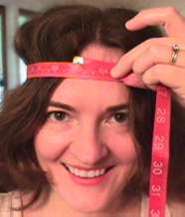
How to Measure YourselfThis page describes how to measure yourself. It is best to have someone help you take these measurements. However, you can see I measured myself because the photographer was busy holding the camera!You will find the following tables containing instructions and pictures:
Click here to |
Head Measurements |
|
| Head circumference:
Wrap measuring tape around head. |
 |
| Where exactly are the shoulders?
Place your hand on the bone at the top of your shoulder. Pivot the arm. If you have the correct location on the bone, your arm should pivot around this point. |
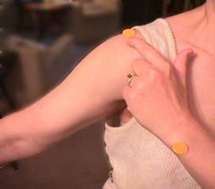 |
| Neck circumference:
Wrap measuring tape around base of neck. |
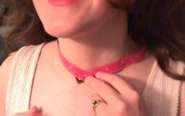 |
| Fullest part of chest or bust:
Measure around the fullest part of your bust. I placed dots on the high part of the bust. You can't see them because the tape is covering them. You will be asked to specify a bust ease. The ease will be added to the bust measurement to determine the width of the sweater at the bust. |
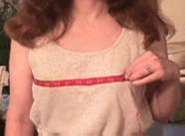 |
| Highest part of chest or bust:
Measure around the highest part of your chest chest directly under arms. Note, this is above the fullest part of the chest. You can see the bust dots in this picture. (This measurement is not used yet. This will be used when darts are implemented. |
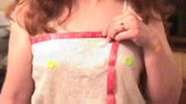 |
| Bust depth:
Measure from neck point down to fullest part of bust. I am measuring down to the green marker on the bust point; you can see the marker in the "high chest" picture.. You can't see the marker here because it is covered! (Not used yet. This will be used when darts are implemented. |
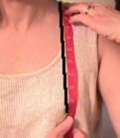 |
| Back waist length:
Measure from the bone at the top of your spine down to your waist level. Notice the elastic tape tied around my waist. This helps locate the waist. An extremely accurate measurement is not required, but it's convenient to know where your waist is when selecting a sweater length. You will be asked to specify an amount for blousing ease. If you are designing a sweater that blouses, place a number in there. |
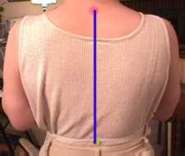 |
| Bicep circumference:
Wrap tape around bicep. You will be asked to specify bicep ease. This value is added to the bicep to determine the width of the sleeve at the bicep level. |
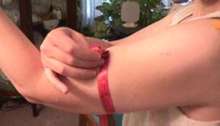 |
| Elbow circumference:
Wrap tape around elbow. You will be asked to specify elbow ease. This value is added to the bicep to determine the width of the sleeve at the elbow level. |
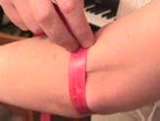 |
| Wrist circumference:
Wrap tape around wrist. You will be asked to specify wrist ease. This value is added to the bicep to determine the width of the sleeve at the wrist level after the cuffs. In some cases you can also specify the cuff ease. This is the ease where ever the cuff actually is. I like a very small cuff ease and a larger wrist ease. |
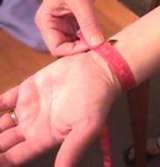 |
Waist and Hip Measurements |
|
| Waist:
Place the tape around your natural waist. You will be asked for waist ease. This is only used for a few sweater shapes-- none of which have been activated. |
 |
| Hip circumference:
Place the tape around the fullest part of your hip. This may be quite low! Don't cheat! You will be asked for hip ease. |
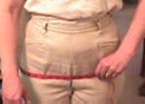 |
| Distance from your waist to the fullest part of hip: | This is a vertical measure. Put the tape at the level of your waist then measure down to the location where your hips are fullest. This is difficult to do. Tying elastic strings around both your waist and hips will help. Fortunately a precise measurement isn't necessary for most sweaters. It is useful to know when evaluating the length of a sweater. |
Armhole and Shoulder MeasurementsNote: The armscye and armhole measurements depths are redundant. Some people like to use one; some like to use the other. The Knitting Fiend will use which ever results in a deeper armhole. |
|
| Snug armscye:
Place the one end of a tape measure on your shoulder on that same little pin you used for the shoulder and arm length measurements. Then wrap the tape under your armpit and back up to the same pin shoulder. Hold the tape comfortably snug. You will be asked for armscye ease. |
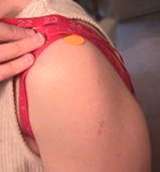 |
|
Armhole depth:
|
No picture yet. |
| Shoulder slope:
As far as I can figure out, the shoulder slope is not a direct body dimension. My recommended values are based on average values suggested in a number of sweater pattern drafting books. I use the default, and then examine the fit until I finally know what's right for me. This is the method recommended in my Vogue Sewing book. |
No picture. |
How to measure when no one is around to help you! |
|
| Put on a long sleeved shirt. Place dots in the appropriate
places. Remove the shirt and measure between the dots!
Shirt with dots:
|
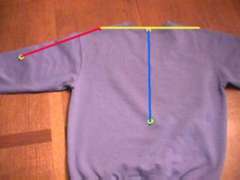 |
How to print these instructions.
If your browser permits no control over printing width, then the page should print out nicely on a standard 8" wide sheet (20.32 cm for you SI types). If your browser permits lots of control over printing, (like more recent versions of IE) the print out may end up narrow! How narrow depends on the width of your computer screen and the setting you select. But you can fix that. So, for those with "snazzy" newer versions of Internet Explorer. If this prints out narrow, and that bugs you, do this: |
| Click here to return to my main page.
Click these to get back to a desired location on this measurement page.
Clicking on the underlined words above will take you straight to the correct location on the page. Otherwise, you may scroll up. |
Copyright © The Knitting Fiend, All Rights Reserved.